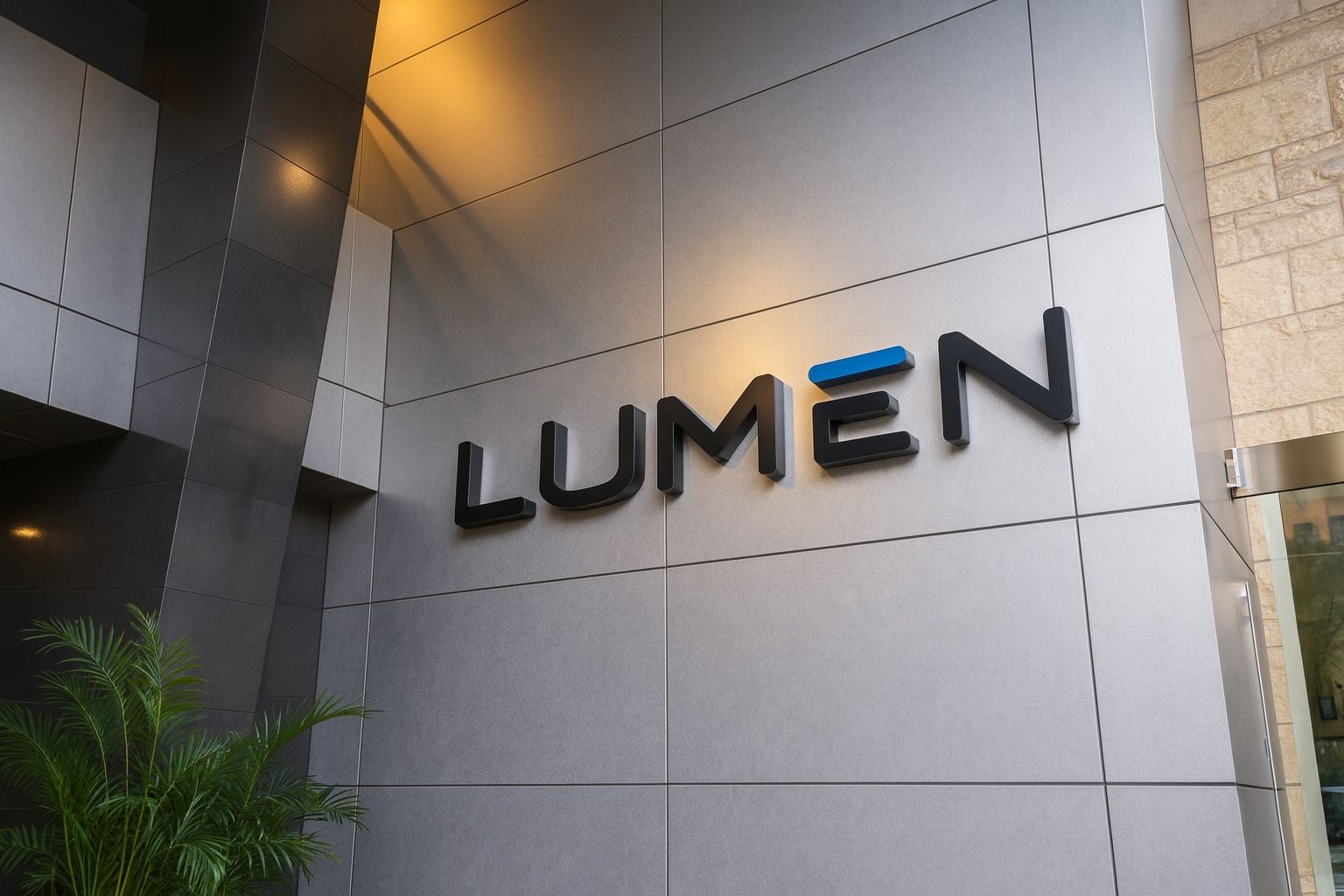- Stock Jumps on AI Deal: Lumen Technologies (NYSE: LUMN) shares climbed after the company unveiled a multi-year partnership with Palantir Technologies to accelerate enterprise AI adoption [1]. Lumen agreed to invest over $200 million in Palantir’s software as part of the deal [2], which sent LUMN stock up about 3% in pre-market trading and as much as 6% intraday on Thursday [3]. As of Oct. 23, the stock traded around $7.21 (+2.3%) [4], marking a sharp rebound from its 52-week low of roughly $3.02 [5].
- Six-Month Rally & YTD Outperformance: Lumen’s stock has more than doubled since April, rocketing ~133% in the past six months to recent highs around $7 [6]. Year-to-date, LUMN is up about 33% [7], far outperforming larger telecom peers – for example, AT&T is up ~12% in 2025 [8] – as investors respond to Lumen’s turnaround narrative. Even after this surge, LUMN remains below its 52-week peak of ~$10.32 [9], suggesting room for recovery if growth accelerates.
- Strategic Overhaul Underway: The company is undergoing a major transformation from a legacy telecom to an AI-era infrastructure provider. Lumen agreed in May to sell its entire consumer fiber business to AT&T for $5.75 billion in cash [10] – a move to exit low-growth residential services and sharpen its focus on enterprise networking while slashing capital expenditures. Simultaneously, Lumen launched a multi-billion-dollar network expansion plan to double its U.S. fiber network, adding 34 million new intercity fiber miles by 2028 (to reach 47 million total) [11]. Executives have branded Lumen as the “trusted network for AI,” touting that these investments will provide the scale, speed, and ultra-low latency needed to power next-generation AI workloads [12].
- Financial Momentum and Challenges: Lumen surprised the market in Q2 2025 by posting a smaller loss than expected (an adjusted –$0.03 per share vs. –$0.26 consensus) [13] and raised its 2025 free cash flow (FCF) guidance by more than 60% to $1.2–1.4 billion [14]. CFO Chris Stansbury credited “strong performance” and tax law changes for boosting cash flow, which “allows us to invest” in growth [15]. The company reaffirmed its full-year EBITDA outlook and now projects an inflection point in 2026, when new digital services revenue (cloud, AI, fiber) is expected to outpace legacy telecom declines [16]. Debt reduction is also in focus – upon closing the AT&T fiber sale in early 2026, Lumen expects to cut its gross debt by ~35% (to ~$13.2 billion) and nearly halve annual interest expense to ~$700 million [17]. Still, Lumen carries a heavy debt load and continues to post declining year-over-year revenues [18], underscoring the challenges ahead.
- Analyst and Expert Reactions: The bold pivot has prompted mixed reactions on Wall Street. Citigroup recently upgraded LUMN to a “Buy” and raised its price target from $6 to $7.50 [19], citing the company’s accelerating fiber buildout and enterprise focus. Some tech analysts are bullish – one September analysis argued Lumen “is fast becoming a serious contender in the AI race,” calling the stock a Strong Buy [20]. Likewise, a Seeking Alpha contributor this week noted Lumen’s pivot “from survival to AI-driven growth” via debt cuts and cost optimization, suggesting a potential valuation upswing ahead [21]. However, others urge caution: Lumen’s revenue has shrunk ~9.5% annually over the past five years [22], which one research firm says signals a “low-quality business” with shaky fundamentals [23] [24]. Independent ratings remain lukewarm (the stock carries mostly Hold ratings with at least one “Sell (D–)” grade as of October) [25]. Market forecasts diverge sharply – for example, 24/7 Wall St. recently predicted LUMN could sink to ~$4.60 (–34%) by year-end if execution falters [26], while optimistic models see significant upside if Lumen hits its $3.5 billion+ EBITDA targets by 2026 [27].
- Upcoming Earnings & Insider Confidence: All eyes are now on Lumen’s Q3 2025 earnings, due October 30 after market close. Analysts expect another net loss (consensus –$0.20 EPS) on roughly $3.04 billion revenue [28], reflecting ongoing legacy declines. Any updated guidance or progress on the AI initiatives will be closely watched. Notably, Lumen’s top executives have shown confidence by buying shares during the stock’s lows – CEO Kate Johnson purchased ~135,870 shares at $3.69, and CFO Chris Stansbury bought 42,000 shares at $4.29 earlier this year [29]. This insider buying, combined with the company’s aggressive restructuring and new partnerships, has bullish investors betting that a turnaround is gaining traction.
Lumen Stock Rallies on Game-Changing Palantir Partnership
Lumen’s new multi-year AI alliance with Palantir is a cornerstone of its transformation strategy, aiming to fuse advanced data analytics with Lumen’s global network. The deal is seen as a bold bid to monetize AI at scale, and it immediately boosted market sentiment toward LUMN stock.
Lumen sent shockwaves through the telecom and tech markets on October 23 by announcing a sweeping partnership with Palantir Technologies, a leading AI and data analytics firm. The multi-year agreement, unveiled early Thursday, will integrate Palantir’s Foundry and AI platform with Lumen’s high-performance fiber network, enabling enterprise customers to deploy AI applications more quickly and securely [30]. In practical terms, Lumen is committing over $200 million to adopt Palantir’s software across its operations in coming years [31] – a signal that Lumen aims to reinvent itself as a digital platform company rather than a traditional phone carrier.
Investors reacted swiftly. LUMN stock jumped about 3% in pre-market trading on the news and rose as much as 6% during Thursday’s session [32], before settling around $7.21 by midday (up roughly +2.3%) [33]. This pop added to an already impressive rally in recent months, and it came amid high trading volume as markets digested the implications of Lumen’s AI push. By partnering with Palantir – known for its cutting-edge data analytics and government AI projects – Lumen gains a marquee tech ally to bolster its credibility in the artificial intelligence space. “The partnership will be about ‘accelerating the transformation, and making lots of money,’” Palantir CEO Alex Karp quipped, emphasizing the mutual growth opportunity [34]. Palantir’s stock (PLTR) was modestly lower on the day, but Lumen’s climb suggested investor optimism that this collaboration can unlock new revenue streams.
Crucially, Lumen’s CEO Kate Johnson framed the deal as a catalyst to evolve Lumen’s identity. “Palantir is helping us with our transformation, and as part of that, we’re going to market together to drive the same for our joint customers,” Johnson said, highlighting that Lumen wants to deliver Palantir’s AI capabilities to its own enterprise clients [35]. In other words, Lumen will not only use Palantir’s software internally (to optimize its networks and operations) but will also act as a channel to offer Palantir-powered services (like advanced analytics and AI solutions) to businesses over Lumen’s network. This could open up a new business line for Lumen, leveraging its global fiber footprint to host and distribute AI applications (such as edge AI processing, IoT analytics, etc.) for corporate and government customers.
Financial analysts note that the partnership aligns with Lumen’s broader ambition to shed its image as a debt-laden, shrinking telecom and recast itself as a next-gen tech infrastructure provider. “Lumen has been looking to move away from a traditional telecommunications provider to a more technology infrastructure company,” observed an analyst summary of the Bloomberg report on the deal [36]. Indeed, under CEO Kate Johnson’s leadership, Lumen has explicitly embraced the tagline of being “the backbone of the AI economy.” Thursday’s Palantir announcement appears to be a concrete step toward that vision, giving Lumen access to world-class AI tools and a potential competitive edge in serving data-intensive industries.
From a market perspective, the Palantir alliance also provided a much-needed confidence boost. Lumen’s stock, which languished below $4 just a few months ago, has been mounting a comeback on hopes that the company’s radical changes will reignite growth. News of a deep collaboration with a high-profile AI firm helped validate Lumen’s tech-forward strategy in the eyes of investors. It suggests that not only is Lumen investing in AI internally, but top-tier tech companies see value in partnering with Lumen – a vote of confidence in the company’s network assets and customer base. “Lumen’s stock has gained about 33% year-to-date,” Reuters noted after the deal [37], and the Palantir news added fuel to that momentum. The true test, however, will be execution: Lumen must demonstrate in coming quarters that this AI partnership can meaningfully improve its financial performance (through new contracts or cost savings) to justify the market’s newfound enthusiasm.
From Penny Stock to Rebound: LUMN’s Dramatic Market Journey
Just a year ago, Lumen Technologies was often regarded as a troubled outlier in the telecom sector – its shares had collapsed to penny-stock territory amid shrinking revenues and a dividend cut that rattled income investors. The company (formerly known as CenturyLink) was grappling with the secular decline of landline phone and legacy data services, and heavy debt from past acquisitions weighed on its balance sheet. In late 2022 and early 2023, LUMN stock plunged under $4, reflecting dire market sentiment and even raising questions about the company’s solvency. By early 2025, Lumen hit a 52-week low around $3.02 per share [38].
Fast forward to October 2025, and the narrative has sharply turned. Lumen’s stock has staged a remarkable rally over the past six months, climbing from the low-$3 range in April to above $7 in recent weeks – a surge of roughly 133% [39]. In effect, LUMN has more than doubled in value since spring, rewarding contrarian investors who bought in at the depths of pessimism. The stock’s year-to-date performance now stands at about +33% [40] (versus the S&P 500’s roughly 12% gain for the same period), making Lumen one of 2025’s more surprising rebound stories in tech/telecom. This huge upswing has pushed Lumen’s market capitalization back above $7 billion [41], up from around $3–4 billion at its lows, and has dramatically lowered its forward valuation multiples. For instance, even after the rally, Lumen trades around 2.2× forward EV/EBITDA, which is extremely low by industry standards [42] – a sign that investors are still pricing in significant risk, but also that the stock could re-rate higher if Lumen’s turnaround gains traction.
What’s driving this recovery? In large part, strategic actions and investor confidence. The rally picked up steam after Lumen’s second quarter (Q2) results in late July showed clear evidence of improvement: the company beat earnings expectations (posting only a slight $0.03 adjusted loss per share vs. much larger expected loss) and raised its full-year cash flow outlook by a wide margin [43] [44]. Raising guidance was a pivotal signal – it suggested that Lumen’s cost-cutting and restructuring efforts were yielding fruit faster than anticipated. The stock leapt in response to the Q2 news, and that momentum continued into August and September as Lumen rolled out more elements of its new strategy (network expansion plans, product launches, etc.). On October 6, for example, LUMN spiked over 10% in a single day amid positive buzz about its enterprise AI network plans [45] and speculation that the worst of its financial decline might be over. Such swings indicate that trader sentiment flipped bullish as Lumen began to show it can execute on its promises.
It’s worth noting that while Lumen’s recent stock gains are impressive, the shares are still a far cry from their past highs. Just five years ago, in 2020, Lumen (then CenturyLink) traded above $15, and even in early 2022 it hovered around $12 before plunging. The current ~$7 price is roughly where the stock was in mid-2022 after a steep drop – so the company has essentially clawed back some lost ground. Long-term shareholders who weathered the volatility have yet to be made whole, and many headwinds remain. But the market’s willingness to more than double Lumen’s value in half a year underscores a fundamental shift: investors are no longer viewing Lumen as a near-hopeless case, but rather as a potential turnaround play with significant upside if management can deliver. This re-rating has also been fueled by a broader thematic tailwind – AI hype. In 2023–2025, anything related to artificial intelligence and advanced networking has attracted interest (and higher valuations) from the market. Lumen’s repositioning as an “AI infrastructure” story tapped into that narrative, helping to change its perception from a dull, high-debt telco to a company with a plausible growth angle.
To put Lumen’s rebound in context, look at its peers: AT&T and Verizon, the U.S. telecom giants, have seen relatively muted stock movements this year (AT&T is up roughly 10–15% including dividends [46], while Verizon’s stock is roughly flat). Both incumbents face their own challenges with debt and sluggish revenue, but neither has experienced anything close to Lumen’s volatility or upside. Lumen’s smaller size and focus make it inherently more volatile – and more capable of extreme swings as sentiment shifts. Unlike AT&T or Verizon, which are heavily tied to consumer wireless and media, Lumen is now essentially an enterprise-focused fiber provider, more comparable to niche players like Zayo Group or Cogent Communications. This niche status may have allowed Lumen’s stock to be more responsive to strategic news. When Lumen announced a major network build or an AI partnership, it moved the needle on the stock in a way similar headlines might not for AT&T (due to its diversification and sheer scale). In summary, Lumen has transformed from an under-the-radar, distressed equity into one of the most intriguing comeback stories in the tech/telecom arena this year – with high risk, but also potentially high reward if the company’s bet on fiber and AI pays off.
Reinventing a Telecom: Inside Lumen’s Strategic Transformation
Central to Lumen’s turnaround plan is a sweeping strategic overhaul – essentially, a top-to-bottom reinvention of what the company does and how it makes money. In the span of a few years, Lumen has executed or announced a series of dramatic moves aimed at pivoting away from stagnant legacy businesses and toward high-growth opportunities in fiber networking, cloud, and artificial intelligence. CEO Kate Johnson, who took the helm in late 2022, has been the architect of this transformation. “Lumen is determined to lead the transformation of our industry to meet the demands of the AI economy,” Johnson proclaimed during a recent industry analyst forum [47]. Backing up that vision, the company laid out a three-pillar strategy: (1) build out the network infrastructure “for the AI economy,” (2) transform its services into a digital, on-demand platform (often called network-as-a-service), and (3) create a connected ecosystem with tech partners (like the Palantir deal) to deliver new solutions [48].
One of the most visible steps Lumen has taken is the massive expansion of its fiber optic network. In September, Lumen announced it is accelerating a multi-billion-dollar network buildout across the United States [49]. The goal is to more than double the size of Lumen’s intercity fiber footprint, bringing it from 13 million miles to 47 million fiber miles by 2028 [50]. This “Big Build,” as Lumen calls it, will add 34 million new fiber miles crisscrossing North America, including major long-haul routes between data centers and cities. By the end of this year (2025), Lumen expects to have delivered about 2.2 million of those new miles already [51], ramping total intercity mileage to ~16.6 million. The expansion also involves installing new high-capacity optical equipment: Lumen has upgraded its network with at least 5.9+ petabits per second of additional capacity so far in 2025 [52], and is deploying advanced 400 Gbps links (with plans for 1.6 Tbps in the future) to ensure ultra-fast data throughput [53]. As Kye Prigg, Lumen’s EVP of Enterprise Operations, put it: “AI is fueling a surge in network demand like we’ve never seen, and Lumen is building the backbone to meet it… This isn’t incremental – we plan to more than double the size of our U.S. network” [54]. By laying so much new fiber and boosting capacity, Lumen aims to position itself as the go-to network for AI workloads – capable of shuttling vast amounts of data between clouds, data centers, and edge devices with minimal delay. In fact, Lumen boasts that its network can now deliver latency under 5 milliseconds to 97% of U.S. business locations, thanks to its extensive fiber routes [55].
While Lumen builds out its network, it’s also fundamentally changing its product offerings and corporate portfolio. A cornerstone of this was the decision to divest non-core businesses that don’t fit the new vision. The most notable example: in May 2025, Lumen agreed to sell its entire U.S. consumer fiber broadband unit to AT&T for $5.75 billion [56]. This deal involves millions of residential internet customers (mostly in 20 states that Lumen/CenturyLink served) being handed off to AT&T. Strategically, it’s a bold retreat from the consumer market – Lumen essentially said it would no longer try to compete in providing home internet or phone service, instead focusing exclusively on enterprise and wholesale networks. The rationale is that enterprise and cloud networking is where Lumen sees growth and where it can differentiate (with things like low-latency fiber routes and integrated IT solutions), whereas the consumer side required heavy capex (building fiber-to-home networks) for relatively lower returns. By selling to AT&T, Lumen not only got a cash infusion to help pay down debt, but it offloaded the future capital expenditure burden of expanding fiber to households. “A move aimed at sharpening its enterprise focus and reducing capital expenditures,” is how Reuters described the divestiture [57]. The deal is expected to close in the first half of 2026 [58], pending regulatory approvals. Importantly, once it closes, Lumen plans to use the proceeds to slash its debt – management estimates the company’s gross debt will drop by over one-third, from about $20.5 billion to ~$13.2 billion [59]. Annual interest costs would plunge nearly 50%, saving roughly $600 million per year [60], which can be redirected into network upgrades and new tech. This kind of balance-sheet transformation is critical because Lumen’s heavy debt and interest expenses have long been an overhang on its finances.
Another facet of Lumen’s strategy is retooling its services into a cloud-like model. The company often speaks of “cloudifying” its network – essentially turning physical connectivity into on-demand, software-driven services. Lumen’s Chief Technology Officer Dave Ward explained that by “cloudifying our fiber assets into software and disrupting cloud economics, we’re giving customers the ability to turn up services within minutes.” [61] He’s referring to initiatives like Lumen Network-as-a-Service (NaaS), an online platform where business customers can configure and purchase network services (like bandwidth, VPNs, edge computing resources) in a self-serve, instant way, rather than through long telco contracts. For example, Lumen recently launched Wavelength RapidRoutes, a service promising ready-to-deploy 100 Gbps and 400 Gbps optical connections with a delivery SLA of just 20 days [62] – vastly faster provisioning than traditional telecom circuits. It also rolled out Lumen Edge computing nodes in multiple cities, and is introducing new products such as Lumen Fabric (a cloud connectivity port, coming in Q4 2025) and Lumen Connect (expected in early 2026) to simplify multi-cloud networking [63]. By offering these agile services, Lumen hopes to capture enterprise clients that need flexible, high-bandwidth links for AI and data. Essentially, Lumen wants to behave more like a tech company (with subscription and usage-based services delivered via software) rather than a static bandwidth provider.
Underpinning everything is a cultural and branding shift. Lumen has fully embraced the tagline “The Trusted Network for AI.” At its Industry Analyst Day in late September, the company showcased a comprehensive “AI-era transformation blueprint,” highlighting how every aspect of the business – from network build-outs to product development to partnerships – is being aligned to serve the coming explosion of AI-driven demand [64] [65]. CEO Kate Johnson, who actually came out of retirement to take on this challenge, has frequently appeared in media and forums to articulate this vision. In a CNBC interview on Oct. 23 (coinciding with the Palantir news), Johnson emphasized that “we’re building the backbone of the AI economy” and discussed how Lumen’s network upgrades are crucial for enabling AI applications that require massive data throughput in real time [66]. She has also spoken about “cultural rewiring” within Lumen – retraining staff and shifting the company mindset from a slow-moving utility to an innovative tech player [67].
All these strategic maneuvers represent a high-stakes bet: Lumen is effectively betting its future on becoming a premier digital infrastructure provider just as the AI revolution and cloud computing proliferation demand ever more bandwidth and connectivity. If the bet pays off, Lumen could stabilize its revenues (which have been declining ~5-10% annually in recent years) and eventually return to growth by tapping new markets. The company’s CFO Chris Stansbury told analysts that 2026 should be the “inflection point” – the year Lumen’s new digital revenue streams finally offset the legacy voice/data declines [68]. By 2028, Lumen even forecasts that its business segment will be growing and that total company revenue could start ticking up again [69], something not seen in a long time. Of course, such long-range forecasts need to be taken with a grain of salt given the execution risks. But it’s clear that management is laser-focused on a long-term turnaround. The next sections will examine how Lumen’s financials are evolving and what experts are saying about its prospects.
Financial Checkup: Can Lumen Turn Investment into Profits?
Despite the exciting strategic story, Lumen’s financial performance remains a work in progress. The company is still dealing with the aftermath of years of revenue decline and heavy debt. However, recent quarters show glimmers of improvement that management hopes to build on.
In the second quarter of 2025, reported on July 31, Lumen delivered a notable upside surprise. The company’s adjusted loss was only $0.03 per share, far better than analysts’ consensus of a $0.26 loss [70]. This means Lumen essentially broke even on an operating basis, excluding some charges, which was a relief to investors expecting a much deeper red ink. Revenues in Q2 were $3.09 billion, which actually slightly missed the $3.11 billion expectation [71], but the shortfall was explained by a one-time factor: a $46 million revenue giveback related to a rural broadband subsidy, triggered by Lumen’s sale of assets [72]. Stripping that out, the top-line was roughly on target, indicating that the company’s decline may be stabilizing somewhat. More importantly, Lumen significantly raised its free cash flow (FCF) guidance for 2025 – from a prior range of $700–900 million to a new range of $1.2–1.4 billion [73]. That’s a huge jump (over 60% at the midpoint) and was driven partly by operational cost savings and partly by an external factor: changes in U.S. tax law allowing better interest expense deductions. “We’re taking it (guidance) up considerably because of strong performance, but also because of the new tax bill… that definitely benefited us and allows us to invest,” CFO Chris Stansbury told Reuters [74]. Indeed, one silver lining for Lumen amid rising interest rates is that a recent tax legislation improved its ability to deduct interest costs, boosting near-term cash flow [75]. With more than $1 billion in FCF now expected this year, Lumen has a bit more breathing room to fund its network projects without needing to raise new debt imminently.
Encouragingly, Lumen’s leadership said that earnings metrics are bottoming out. They reaffirmed the company’s full-year 2025 Adjusted EBITDA guidance of $3.2–3.4 billion and even indicated results will likely hit the high end of that range [76]. And looking further ahead, CFO Stansbury and CEO Johnson have outlined that by trimming costs and divesting lower-margin businesses, Lumen’s profitability should improve. The company has a program to cut $1 billion in annual costs by 2027, with an accelerated target of $350 million in cuts by end of 2025 (recently raised from $250 million) [77]. Notably, Johnson credited Palantir’s data analytics for helping identify extra savings, implying the partnership has an immediate ROI in operational efficiency [78]. Additionally, Lumen’s ongoing debt refinancing efforts are starting to pay off. In October, the firm completed a $425 million notes offering (through a subsidiary) and used the proceeds to redeem $373 million of its 10.75% first-lien notes due 2030 [79]. By chipping away at these high-interest obligations, Lumen can lower interest expenses sooner than waiting for the AT&T deal to close. The company’s cash on hand and FCF are being marshaled carefully to manage debt maturities – a key focus area for analysts watching liquidity.
That said, the balance sheet is still under strain. As of mid-2025, Lumen’s total debt was around $20 billion, which is extremely high relative to its market cap and EBITDA. The debt-to-equity ratio is a gaudy ~60x [80] (because Lumen’s shareholder equity is quite low after years of impairment charges and losses). However, this should improve drastically once the asset sale to AT&T goes through and debts are paid down. Liquidity metrics like the current ratio (2.1) are solid [81], indicating Lumen isn’t at immediate risk of running out of cash – a crucial point given the company’s past was plagued by questions of sustainability. One metric that concerned investors was Lumen’s decision in late 2022 to suspend its dividend (it once paid a hefty dividend but cut it to zero to conserve cash). While painful for income-focused shareholders, that move saved roughly $1 billion per year in payouts and is part of why Lumen can now invest in growth initiatives.
Looking ahead to the third quarter (Q3) 2025 earnings, due to be reported on October 30, expectations are muted but hopeful. Wall Street analysts predict Lumen will post a net loss of about $0.20 per share on revenue of ~$3.04 billion [82]. The year-over-year comparison will likely still show a decline (in Q3 2024, Lumen’s revenue was higher, partly due to businesses since divested), but investors are more interested in sequential trends and any guidance update. Specifically, they’ll watch for signs that Lumen’s enterprise revenue is stabilizing or growing thanks to new products, and that margins are improving despite inflationary pressures. It’s worth noting that some of Lumen’s accounting results can be lumpy – for instance, in Q4 2024 Lumen actually reported a one-time profit of $0.49 per share [83] (thanks to a large tax benefit or asset sale), but that was an anomaly. Analysts still forecast losses for full-year 2025 and 2026 [84] as Lumen works through its transition.
One positive sign is insider buying: both the CEO and CFO purchased significant amounts of Lumen stock on the open market earlier this year [85]. CEO Kate Johnson’s buy (~135k shares at $3.69) and CFO Stansbury’s buy (42k shares at $4.29) signal that management truly believes the stock was undervalued and that the company’s prospects will improve. This vote of confidence did not go unnoticed – such insider purchases often bolster investor sentiment, as they imply the people with the best understanding of the business see upside in the stock. Indeed, since those spring purchases, LUMN has climbed well above those prices, meaning management is already “in the money” on their bet – aligning their interests with shareholders.
Finally, it’s important to examine free cash flow and capital spending trends. Lumen’s ability to fund its ambitious network upgrade depends on balancing capex with operating cash. The company has said it will reinvest a large portion of its savings into growth projects (fiber, edge computing, etc.), which means FCF might not grow linearly even if EBITDA improves. However, the raised FCF outlook for 2025 shows Lumen is finding efficiency gains and benefitting from tax changes that together outweigh its increased capex so far. If Lumen can indeed generate over $1.2 billion in FCF this year, that covers its planned capital expenditures and leaves hundreds of millions to put toward debt reduction. The big question is whether this financial momentum is sustainable. Can Lumen continue to cut costs without hurting service quality? Will the new revenue streams (AI services, NaaS, etc.) ramp up quickly enough to offset the steady erosion of legacy telecom revenue? These are the uncertainties that still hang over Lumen’s financial future. The Q3 earnings call next week will be an opportunity for management to provide updates on early customer uptake for products like RapidRoutes or on any initial deals stemming from the Palantir partnership. Strong anecdotes or metrics there could further bolster the bull case, whereas any disappointments or delays might rekindle skepticism.
Wall Street’s Take: Optimism, Skepticism, and What Comes Next
The investment community is sharply divided on Lumen Technologies, making it a stock that inspires both hope and caution in equal measure. Given Lumen’s complex situation – a legacy business in decline attempting a tech-driven rebirth – it’s not surprising that analyst opinions span a wide spectrum. Here’s a look at what financial analysts and industry experts are saying:
On the bullish side, some see Lumen as an undervalued turnaround gem. The company’s forward enterprise-value-to-EBITDA multiple (around 2.2x) is well below industry averages, and bullish analysts argue that as Lumen stabilizes, the stock’s multiple could expand significantly. For instance, Citigroup in late September upgraded LUMN from Neutral to a “Buy” rating, hiking its price target to $7.50 [86]. Citi’s analysts cited Lumen’s progress in refocusing on core fiber operations and the expectation that the upcoming asset sale will strengthen the balance sheet. Another vote of confidence came from Raymond James, which earlier in August raised its target to $5 (from $4.50) and labeled Lumen “Outperform,” essentially a bullish call [87]. Moreover, at least two analysts now rate Lumen a Buy, versus only one outright Sell, with the majority still at Hold [88] – a notable improvement from a year ago when Lumen had virtually no Buy ratings.
Tech-focused commentators also highlight the growth angle. A Seeking Alpha analyst this month upgraded Lumen with a thesis titled “Adjusted EBITDA Is On Pace To Grow In 2026 (Rating Upgrade).” The crux: Lumen’s aggressive debt reduction and cost cuts are setting the stage for EBITDA growth resumption by 2026, which could “trigger a major valuation shift” as the market begins to view Lumen as a growth story rather than a shrinking one [89]. Similarly, a September Yahoo Finance feature (syndicated from The Motley Fool) pointed out that “Lumen stock has more than doubled since April” and noted that several countries and enterprises have recently contracted Lumen for data center connectivity projects, hinting at real demand for its new services [90] [91]. That article acknowledged Lumen’s past struggles but suggested the stock’s incredibly low valuation and momentum made it worth a look for risk-tolerant investors.
Perhaps the most enthusiastic takes frame Lumen as a potential “AI infrastructure play”. One Seeking Alpha contributor went as far as saying Lumen is “fast becoming a serious contender in the AI race” and rated the stock a Strong Buy [92], essentially arguing that Lumen’s assets (like its extensive fiber routes and edge computing nodes) give it an advantage in delivering the huge data flows that AI applications require. To these optimists, Lumen’s transformation under Kate Johnson mirrors past telecom turnarounds (they often cite how Nokia pivoted from phones to networking, or how Cloudflare and others built value by focusing on internet infrastructure), and they believe Lumen’s depressed stock could have multi-bagger potential if the turnaround fully materializes.
On the bearish or cautious side, many observers urge not to get carried away by the AI buzz. They point out that Lumen’s core financial trends – declining revenue, negative earnings, heavy debt – remain concerning. Research firm Weiss Ratings recently slapped Lumen with a lowly “D– (Sell)” grade in October [93], reflecting its quantitative view that the company’s financial health is weak and its risk profile high. Meanwhile, equity research outlets like Wall Street Zen moved Lumen only from Sell to Hold, implying that while bankruptcy risk might have lessened, they still don’t endorse buying the stock [94].
A detailed skeptical view comes from StockStory (an analyst service) which published a report titled “Lumen (LUMN): Buy, Sell, or Hold Post Q2 Earnings?” just this week. Their conclusion: “we’ll be cheering from the sidelines.” Despite acknowledging the recent rally, the StockStory analysts list reasons for caution: Lumen’s revenue has been spiraling downward, with a ~9.5% CAGR decline over five years [95], marking it as a structurally challenged business. They noted that even Lumen’s earnings per share and free cash flow margins have deteriorated over the long term [96] [97], suggesting that the company historically struggled to adjust its costs fast enough to match the revenue drop. “This was below our standards and signals it’s a low quality business,” the report bluntly stated regarding Lumen’s sales erosion [98]. StockStory also warned that at ~2× EV/EBITDA, the stock may appear cheap but that “the potential downside is huge given its shaky fundamentals” [99]. Essentially, bears argue that unless Lumen can truly stop the revenue bleeding and find growth, it could end up in a value trap – a situation where the stock is cheap for a reason and might sink again if the turnaround falters.
Even among those optimistic about Lumen’s strategy, there’s recognition that execution risk is high. Building millions of miles of fiber and rolling out new services takes time – and capital. Lumen’s competitors aren’t standing still either. Giants like AT&T and Verizon are also expanding their fiber backbones (though they focus on consumer fiber too) and investing in 5G, while cable companies and cloud providers (like Amazon, Google) are pushing deeper into enterprise networking. Lumen must carve a profitable niche amid this competition. Some analysts worry that Lumen’s history of acquisitions (CenturyLink’s takeover of Level 3, etc.) left it with a patchwork network that, while extensive, still overlaps with others and doesn’t guarantee pricing power. Moreover, enterprise customers tend to be sticky but also demanding – Lumen will need top-notch reliability and service to win new corporate clients for its AI-era offerings.
Market expectations, as seen in options and short interest, indicate a fair amount of speculation around Lumen. The stock’s volatility (beta ~1.45 [100]) is higher than average, reflecting how news-driven it has become. Notably, some bondholders and creditors appear to have a positive outlook: Lumen managed to get its recent debt refinancing done, and the company noted “broad support across [its] capital structure” for its turnaround plan [101], suggesting creditors believe Lumen can improve (creditors tend to be conservative).
Looking ahead, what do experts predict for Lumen? It truly depends on whether Lumen hits its milestones. A forecast from 24/7 Wall St., for example, projected Lumen’s share price could be around $4.61 by the end of 2025 [102] – a highly bearish outlook that assumes the stock will give back a lot of its gains, likely if earnings disappoint or if the market loses patience. On the flip side, if Lumen demonstrates even a modest return to revenue growth by late 2026 or 2027, the stock could rerate much higher. Some analysts have floated long-term price ranges in the low double-digits (>$10) if things go right, which isn’t implausible given Lumen traded above $10 as recently as mid-2022.
Most likely, 2024 will be the prove-it year for Lumen: investors will want to see concrete evidence that the decline is ending. That means stable or rising sales in key segments like IP transit, fiber transport, edge computing, etc., and continued healthy FCF. The upcoming Q3 and Q4 results, plus management’s commentary on integration of the Palantir partnership and the progress of the big fiber build, will shape the next leg of LUMN’s stock trajectory.
In summary, Lumen Technologies has engineered an impressive short-term comeback, fueled by bold strategic moves and a compelling pitch that it can be an essential enabler in the AI-centric future of networking. The stock’s jump and high trading interest reflect a newfound belief that this 150-year-old telecom (tracing back to the old CenturyLink and Bell systems) might have a second act. Yet, the company is not out of the woods – it must execute quarter after quarter to win over the remaining skeptics. As of now, the story of Lumen is one of calculated reinvention, with a potential payoff that has Wall Street watching closely. Investors in LUMN will be navigating both the promise and peril of a turnaround in progress, making it one of the more dramatic narratives in the tech and telecom market heading into 2026.
Sources: Lumen and Palantir partnership report [103] [104]; Reuters Q2 2025 coverage [105] [106]; Lumen network expansion press release [107] [108]; Investing.com forum summary [109] [110]; MarketBeat and Yahoo Finance data [111] [112]; StockStory analysis [113] [114]; Seeking Alpha and Motley Fool commentary [115] [116]; Reuters/Stocktwits market data [117] [118].
References
1. www.reuters.com, 2. www.reuters.com, 3. stocktwits.com, 4. www.reuters.com, 5. www.reuters.com, 6. markets.financialcontent.com, 7. stocktwits.com, 8. www.marketbeat.com, 9. www.reuters.com, 10. www.reuters.com, 11. ir.lumen.com, 12. ir.lumen.com, 13. www.reuters.com, 14. www.reuters.com, 15. www.reuters.com, 16. www.investing.com, 17. www.investing.com, 18. markets.financialcontent.com, 19. www.marketbeat.com, 20. www.hotcandlestick.com, 21. www.hotcandlestick.com, 22. markets.financialcontent.com, 23. markets.financialcontent.com, 24. markets.financialcontent.com, 25. www.marketbeat.com, 26. 247wallst.com, 27. seekingalpha.com, 28. www.marketbeat.com, 29. www.marketbeat.com, 30. www.reuters.com, 31. www.reuters.com, 32. stocktwits.com, 33. www.reuters.com, 34. stocktwits.com, 35. stocktwits.com, 36. stocktwits.com, 37. stocktwits.com, 38. www.reuters.com, 39. markets.financialcontent.com, 40. stocktwits.com, 41. www.marketbeat.com, 42. markets.financialcontent.com, 43. www.reuters.com, 44. www.reuters.com, 45. stockstotrade.com, 46. www.marketbeat.com, 47. www.investing.com, 48. www.investing.com, 49. ir.lumen.com, 50. ir.lumen.com, 51. ir.lumen.com, 52. ir.lumen.com, 53. www.investing.com, 54. ir.lumen.com, 55. ir.lumen.com, 56. www.reuters.com, 57. www.reuters.com, 58. www.investing.com, 59. www.investing.com, 60. www.investing.com, 61. www.investing.com, 62. www.investing.com, 63. www.investing.com, 64. www.hotcandlestick.com, 65. www.hotcandlestick.com, 66. www.youtube.com, 67. fortune.com, 68. www.investing.com, 69. www.investing.com, 70. www.reuters.com, 71. www.reuters.com, 72. www.reuters.com, 73. www.reuters.com, 74. www.reuters.com, 75. www.reuters.com, 76. www.reuters.com, 77. stocktwits.com, 78. stocktwits.com, 79. www.investing.com, 80. www.marketbeat.com, 81. www.marketbeat.com, 82. www.marketbeat.com, 83. www.marketbeat.com, 84. www.marketbeat.com, 85. www.marketbeat.com, 86. www.marketbeat.com, 87. www.marketbeat.com, 88. www.marketbeat.com, 89. www.hotcandlestick.com, 90. www.hotcandlestick.com, 91. www.hotcandlestick.com, 92. www.hotcandlestick.com, 93. www.marketbeat.com, 94. www.marketbeat.com, 95. markets.financialcontent.com, 96. markets.financialcontent.com, 97. markets.financialcontent.com, 98. markets.financialcontent.com, 99. markets.financialcontent.com, 100. www.marketbeat.com, 101. www.prnewswire.com, 102. 247wallst.com, 103. www.reuters.com, 104. stocktwits.com, 105. www.reuters.com, 106. www.reuters.com, 107. ir.lumen.com, 108. ir.lumen.com, 109. www.investing.com, 110. www.investing.com, 111. www.marketbeat.com, 112. www.marketbeat.com, 113. markets.financialcontent.com, 114. markets.financialcontent.com, 115. www.hotcandlestick.com, 116. www.hotcandlestick.com, 117. stocktwits.com, 118. stocktwits.com








